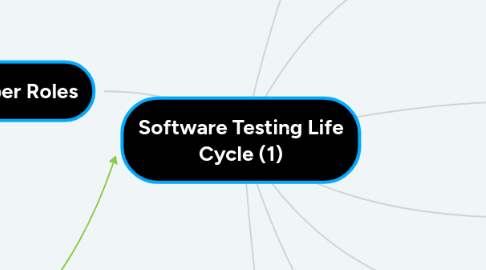Software Testing Life Cycle (1)
by Lucy Silverman

1. Software Developer Roles
1.1. Stakeholders
1.1.1. Group members: - customers - users - UX researchers
1.1.2. Primary functions: - provide requirements
1.1.3. send requirements to leadership
1.2. Leadership
1.2.1. PROJECT MANAGEMENT
1.2.2. Group members: - project managers - product managers - software engineering mgmt
1.2.3. Primary function: - gather requirements - provide requirements to software engineers
1.2.4. Organizational functions: I. planning/project management A. division of labor for SE's i. module segmentation B. scheduling deadlines
1.2.5. divides labor between software engineers; holds standup meetings with software engineers
1.3. Software Engineers
1.3.1. Group Members: - Sr. Developer - Jr. Developer - Front/Back End Developer - Domain Experts
1.3.2. Primary Functions: - coding
1.3.2.1. codes may pass or fail
1.3.3. Organizational Functions: - Status Meetings (Scrum, Standup) - Communication with leaders/stakeholders - Escalation of issues
1.4. QA Testers
1.4.1. Group members: - User Acceptance Testers
1.4.2. Primary Functions: - Testing software in whole or in part
1.4.3. Organizational Functions: - Communicating results - Reporting issues - Recommending changes
2. 1. Requirements Phase or Requirements Analysis
2.1. General Info Tester needs: What areas of the product need to be tested? What functionalities should we focus on? What bug types does the customer want fixed? What features are off-limits to testers? Everything within scope should be tested.
2.2. Test Team studies + analyzes requirements from a testing perspective to understand the scope of this particular test
3. 2. Planning Phase or Test Planning
3.1. First step of the testing process; test manager or lead will determine estimated cost and effort for the project; prepare test plan based on requirements; it is decided which test engineers are going to work on what test, how long will it take, and which bug tracking tools they use, and which automation tools they will use for this release; - considered the most important part of the STLC
4. 3. Test Design or Analysis Phase or Test Case Development
4.1. testing team notes detailed test cases and prepares test data for testing, once test cases are ready, they're reviewed by peers or QA lead "WHAT" is to be tested?
5. 4. Design Phase (Test Environment Setup or Design Phase)
5.1. Test environment is set up based on hardware and software environment list; developers or customers provide the environment - "HOW" to test
6. 5. Test Execution
6.1. Test team executes test cases based on planned test cases
7. 6. Test Closure or Test Cycle Closure
7.1. calling testing team meeting and evaluating cycle completion based on test coverage quality, cost, time, critical business objectives, and software
8. DTL (bug tracking)

